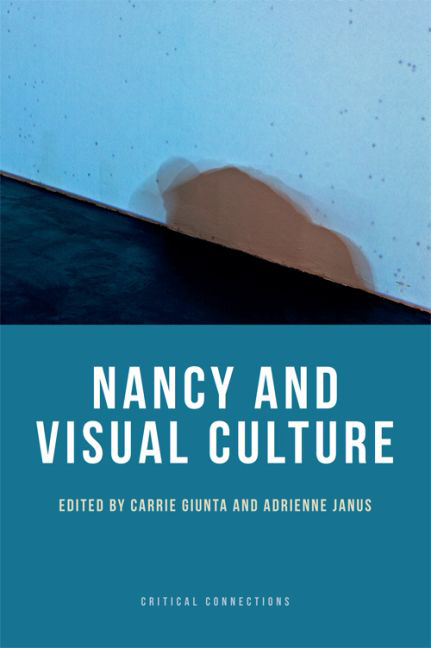Book contents
- Frontmatter
- Contents
- List of illustrations
- Acknowledgements
- Introduction: Jean-Luc Nancy and the Image of Visual Culture
- 1 Cutting and Letting-Be
- 2 Dancing Equality: Image, Imitation and Participation
- 3 A Question of Listening: Nancean Resonance, Return and Relation in Charlie Chaplin
- 4 The Image: Mimesis and Methexis
- 5 On the Threshold: Visual Culture, Invisible Nature
- 6 Pornosophy: Jean-Luc Nancy and the Pornographic Image
- 7 Presentation and Disappearance: Dialogue between Soun-Gui Kim and Jean-Luc Nancy
- 8 Writing in the Place of the Animal
- 9 Together at the Limit: Jean-Luc Nancy, Art and Community
- 10 Turning Around the Written Mark, Opening from a Weight of Thought
- 11 Uncanny Landscapes of Photography: The Partage of Double-Exposure after Jean-Luc Nancy
- Contributors
- Bibliography
- Index
9 - Together at the Limit: Jean-Luc Nancy, Art and Community
Published online by Cambridge University Press: 15 September 2017
- Frontmatter
- Contents
- List of illustrations
- Acknowledgements
- Introduction: Jean-Luc Nancy and the Image of Visual Culture
- 1 Cutting and Letting-Be
- 2 Dancing Equality: Image, Imitation and Participation
- 3 A Question of Listening: Nancean Resonance, Return and Relation in Charlie Chaplin
- 4 The Image: Mimesis and Methexis
- 5 On the Threshold: Visual Culture, Invisible Nature
- 6 Pornosophy: Jean-Luc Nancy and the Pornographic Image
- 7 Presentation and Disappearance: Dialogue between Soun-Gui Kim and Jean-Luc Nancy
- 8 Writing in the Place of the Animal
- 9 Together at the Limit: Jean-Luc Nancy, Art and Community
- 10 Turning Around the Written Mark, Opening from a Weight of Thought
- 11 Uncanny Landscapes of Photography: The Partage of Double-Exposure after Jean-Luc Nancy
- Contributors
- Bibliography
- Index
Summary
This chapter draws from the aesthetic theory of Jean-Luc Nancy and his work on community to think about how an artwork exposes limit and how, as a result of this, it engenders a sense of community. I begin by juxtaposing Nancy with Sophie Calle's 2007 installation Couldn't Capture Death. Calle's artwork seems to present purely the human limit, by revolving around a documentary-like video recording of Calle's mother's death. This work prompts a sense of Nancy's Inoperative Community. It does so because when we enter this installation we co-appear with its object – being-with the ungraspable last moments of this dying lady. This experience exposes our syncopating finitude. It engages Nancy's The Inoperative Community, by defining a sense of community as the communication and sharing of our finitude.
I question what it means to argue that an artwork produces a sense of limit and community. Drawing from one of my own installation artworks, Flashback, I use Nancy's aesthetic and communitarian corpus as a muse to inspire both the creating and comprehending of an immersive installation that uses the senses of smell and touch to evoke an agent of making sense at the limit. This limit is not so much about dying as touching the threshold of a rebirthing process. When people enter my installation, they dwell within and experience this process. Composing and comprising such a dwelling, the installation (temporarily) houses a community.
Nancy helps me understand this as the work of my artwork. Here we share our finitude (and its eternal return of renaissance). To solidify this thesis, and connect my work with that of Calle's, I conclude by constructing a plane of ‘transimmanence’. This plane is Nancean. It draws across (‘trans’) and beyond the power of sensory immanence gained from viewing and making art. This plane locates and houses a logically inoperative but productively aesthetic sense of community. Here we (the community who assemble here) can initiate a touching journey of trying to make sense at the limit brought forward during the aesthetic experience.
Sophie Calle
Sophie Calle's Couldn't Capture Death is an installation artwork that was shown at the Venice Biennale in 2007. It was part of the main international exhibition at this event, which was curated by Robert Storr.
- Type
- Chapter
- Information
- Nancy and Visual Culture , pp. 164 - 180Publisher: Edinburgh University PressPrint publication year: 2016



